In the field of electrical power distribution and transmission, circuit breakers play a crucial role in protecting electrical networks from faults and overloads. Among the various types of circuit breakers, the Vacuum Circuit Breaker (VCB) stands out as a modern and reliable technology for interrupting fault currents and maintaining the stability of electrical systems.
In this article, we will explore the working principle, construction, testing, advantages, and applications of Vacuum Circuit Breakers, shedding light on the advancements in electrical switching technology.
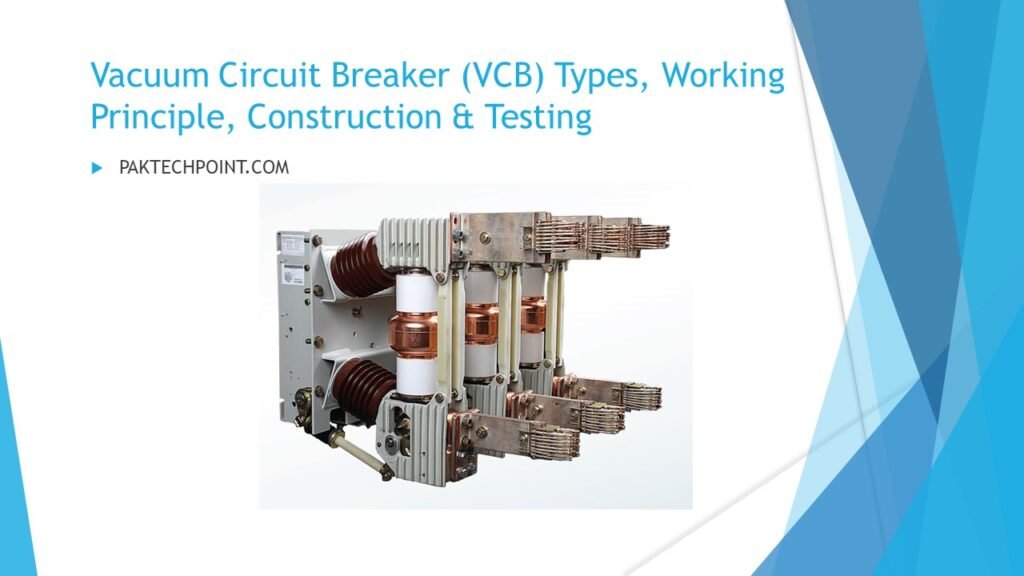
What is Vacuum Circuit Breaker (VCB)?
A Vacuum Circuit Breaker (VCB) is a type of electrical switchgear that is used to control and protect electrical circuits from overloads, short circuits, and faults. It operates on the principle of using vacuum as the arc quenching medium instead of traditional mediums like air, oil, or gas. VCBs are widely used in medium to high voltage applications, typically ranging from 1 kV to 72 kV and even higher.
The main components of a Vacuum Circuit Breaker include the fixed and moving contacts, vacuum interrupter, operating mechanism, and control panel. The vacuum interrupter is the heart of the VCB, where the contacts are enclosed in a vacuum-sealed envelope. When the circuit breaker operates, the contacts separate, and the arc is drawn into the vacuum interrupter, where it gets extinguished due to the absence of any medium to sustain it.
Working Principle of Vacuum Circuit Breaker
The Vacuum Circuit Breaker operates on the principle of utilizing a vacuum as the arc extinguishing medium. Unlike traditional circuit breakers that use air, oil, or SF6 gas, VCBs create a vacuum environment between the contacts. When the contacts are separated during a fault, an arc is initiated. Due to the absence of any ionization medium in the vacuum, the arc cannot be sustained, and the current is quickly interrupted.
Contact Materials in Vacuum Circuit Breaker
The contacts in a Vacuum Circuit Breaker are made from high-quality materials to ensure efficient interruption of fault currents. Typically, the main contacts are composed of copper or copper-chrome, which provides low resistance and high conductivity. The materials used in VCBs are carefully selected to withstand the high heat and stress generated during the switching process.
Construction of Vacuum Circuit Breaker
A Vacuum Circuit Breaker comprises several key components that work together to achieve reliable switching operations. The main components include:
- Vacuum Interrupter: This is the heart of the VCB, where the arc is extinguished. It consists of a fixed and moving contact enclosed in a vacuum-sealed ceramic envelope.
- Operating Mechanism: The operating mechanism is responsible for opening and closing the contacts. It can be either manual or motor-operated, depending on the application.
- Insulating Enclosure: The entire assembly of the VCB is housed within an insulating enclosure to ensure safety and prevent electrical arcing outside the breaker.
- Control Panel: The control panel houses the necessary circuitry and protective relays to monitor and control the operation of the Vacuum Circuit Breaker.
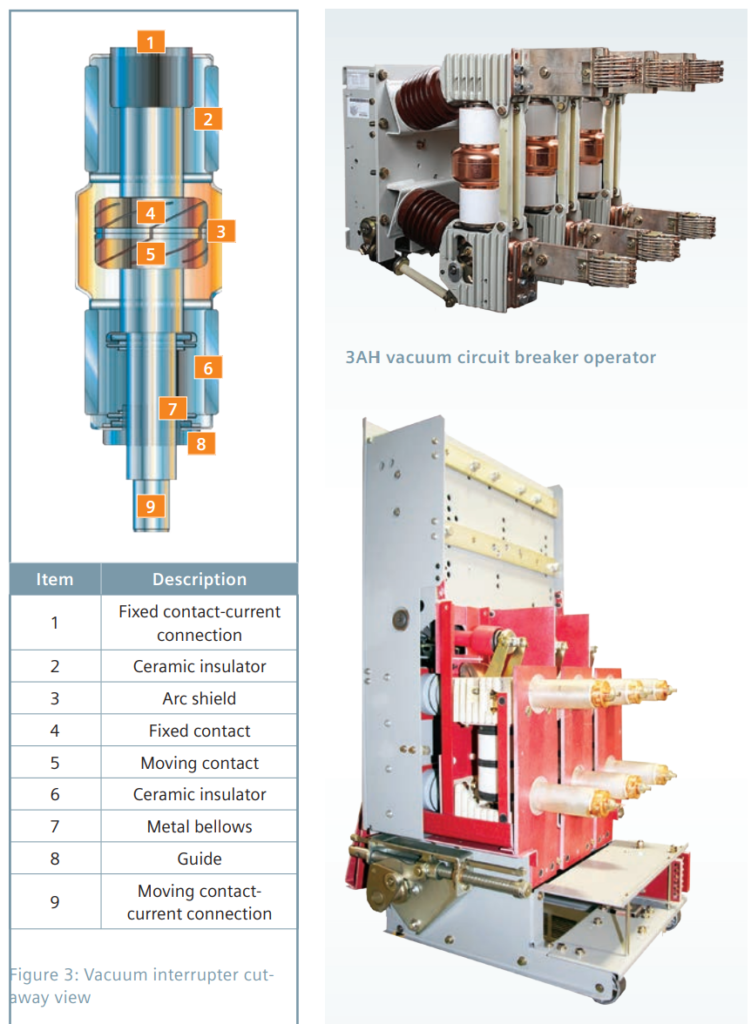
Vacuum Circuit Breaker Current Chopping
One of the challenges faced by VCBs is the phenomenon known as “current chopping.” During the interruption of fault currents, the rapid increase in voltage across the contacts causes a temporary cessation of the arc. This phenomenon is referred to as current chopping, and it may lead to re-striking of the arc, affecting the breaker’s performance. To address this issue, modern Vacuum Circuit Breakers are equipped with advanced arc control techniques and pre-insertion resistors to mitigate the effects of current chopping.
Vacuum Circuit Breaker Testing
The reliability and performance of Vacuum Circuit Breakers are crucial for the safety of electrical networks. Therefore, rigorous testing is carried out during the manufacturing and installation process. Some of the key tests include:
- Vacuum Integrity Test: This test ensures the vacuum integrity of the interrupter by measuring the vacuum level and leakage rate.
- Dielectric Withstand Test: It verifies the insulation capability of the VCB by applying high voltage across the contacts.
- Short Circuit Test: The VCB is subjected to short-circuit currents to assess its ability to interrupt high fault currents.
Vacuum Contactor Unit
Apart from being used as circuit breakers, Vacuum interrupters are also employed in Vacuum Contactor Units (VCUs). VCUs are designed for switching and controlling high current loads, such as motors and transformers. They provide a reliable and maintenance-free solution for power distribution and control applications.
Advantages and Disadvantages of Vacuum Circuit Breaker
Below is a table outlining the advantages and disadvantages of Vacuum Circuit Breakers (VCBs):
| Advantages | Disadvantages |
|---|---|
| High Dielectric Strength | Limited Breaking Capacity |
| Environmentally Friendly (No SF6 Gas) | Higher Initial Cost |
| Low Maintenance Requirements | |
| Faster Switching Speed | |
| Suitable for High Voltage Applications | |
| Reliable and Efficient Operation | |
| Wide Range of Applications |
Applications of Vacuum Circuit Breaker
Vacuum Circuit Breakers find extensive applications in various industries and power systems. Some common applications include:
- Power Distribution Networks: VCBs are used in medium to high voltage distribution networks for protecting electrical systems from overcurrents and short circuits.
- Industrial Installations: Vacuum Circuit Breakers are employed in industrial facilities to control motors, generators, and transformers.
- Railways: VCBs are used in traction systems for rapid switching of currents in trains and electric locomotives.
- Power Plants: VCBs play a critical role in power generation plants, ensuring the safe and reliable operation of power transformers and generators.
Operation:
Stored-energy operating mechanism (circuit breaker shown in OPEN position) (straight linkage shown)
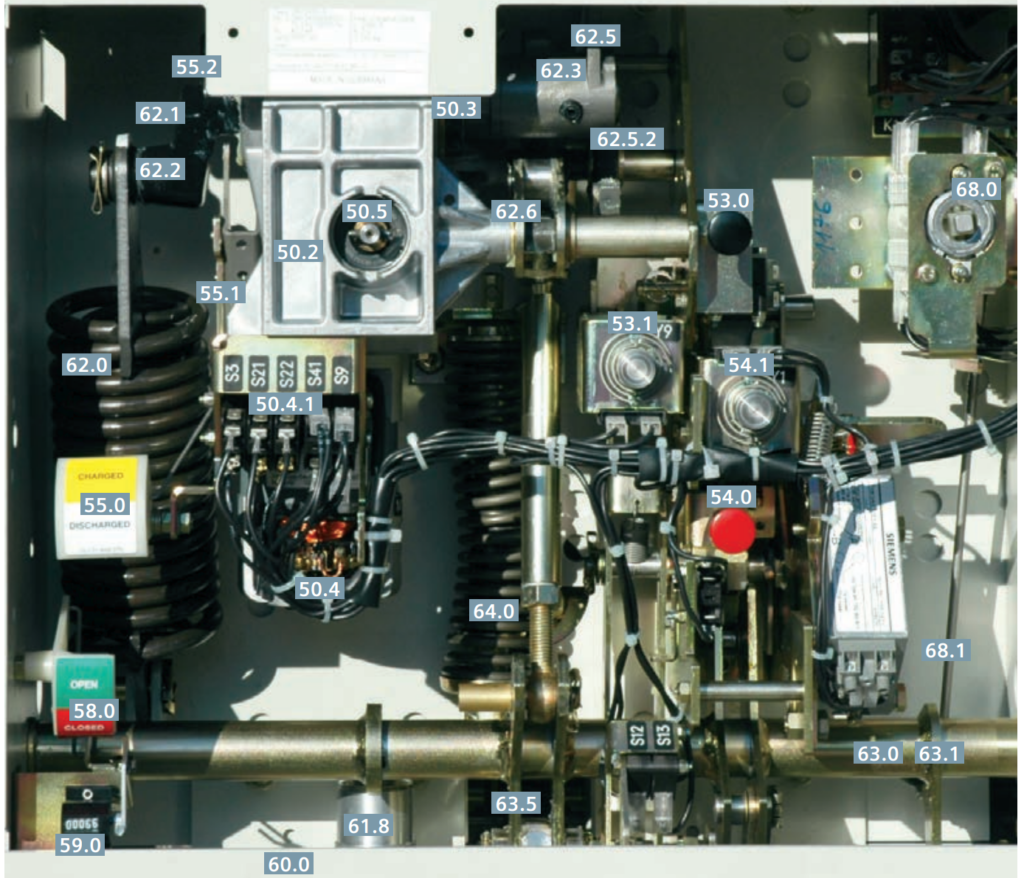
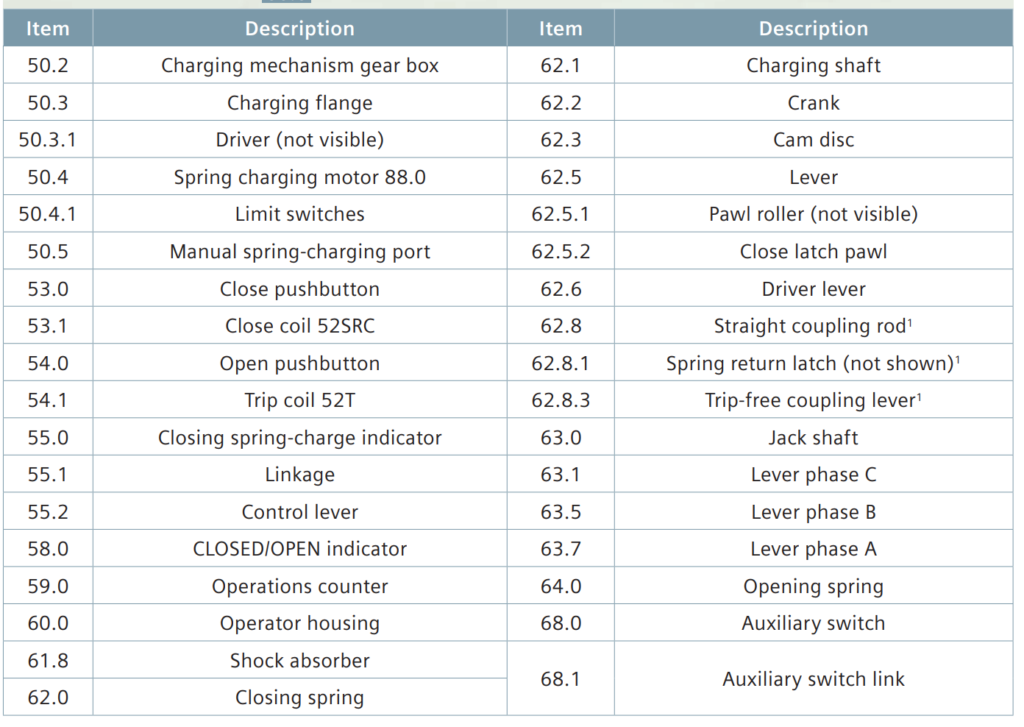
For certain applications, the straight trip coupling rod (62.8) is replaced by a collapsible trip-free coupling system, illustrated in Figures 6-10.
Stored-energy operating mechanism (circuit breaker shown in CLOSED position) (Drawout trip-free linkage shown)
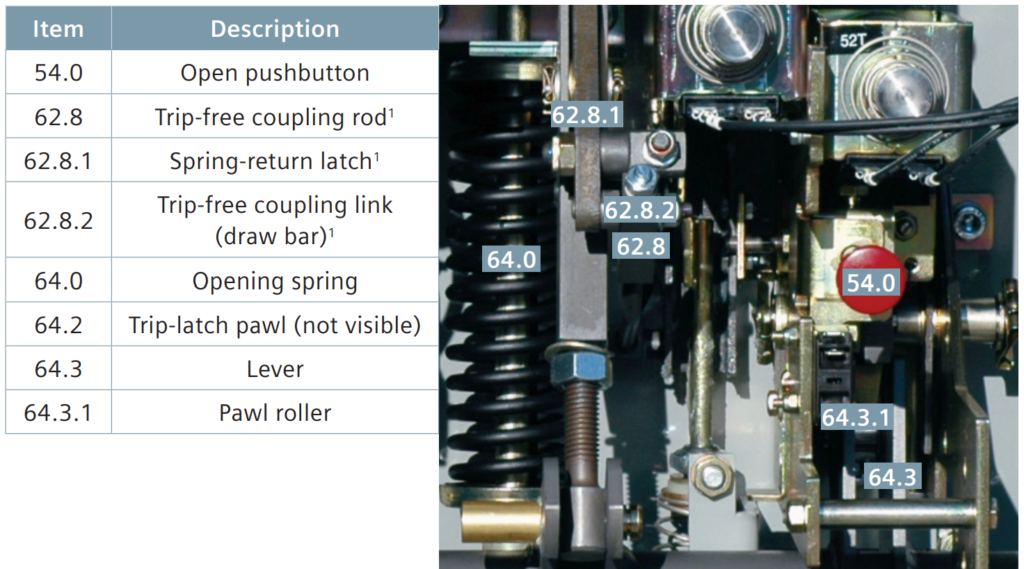
Typical elementary diagram of Vacuum Circuit Breaker (VCB)
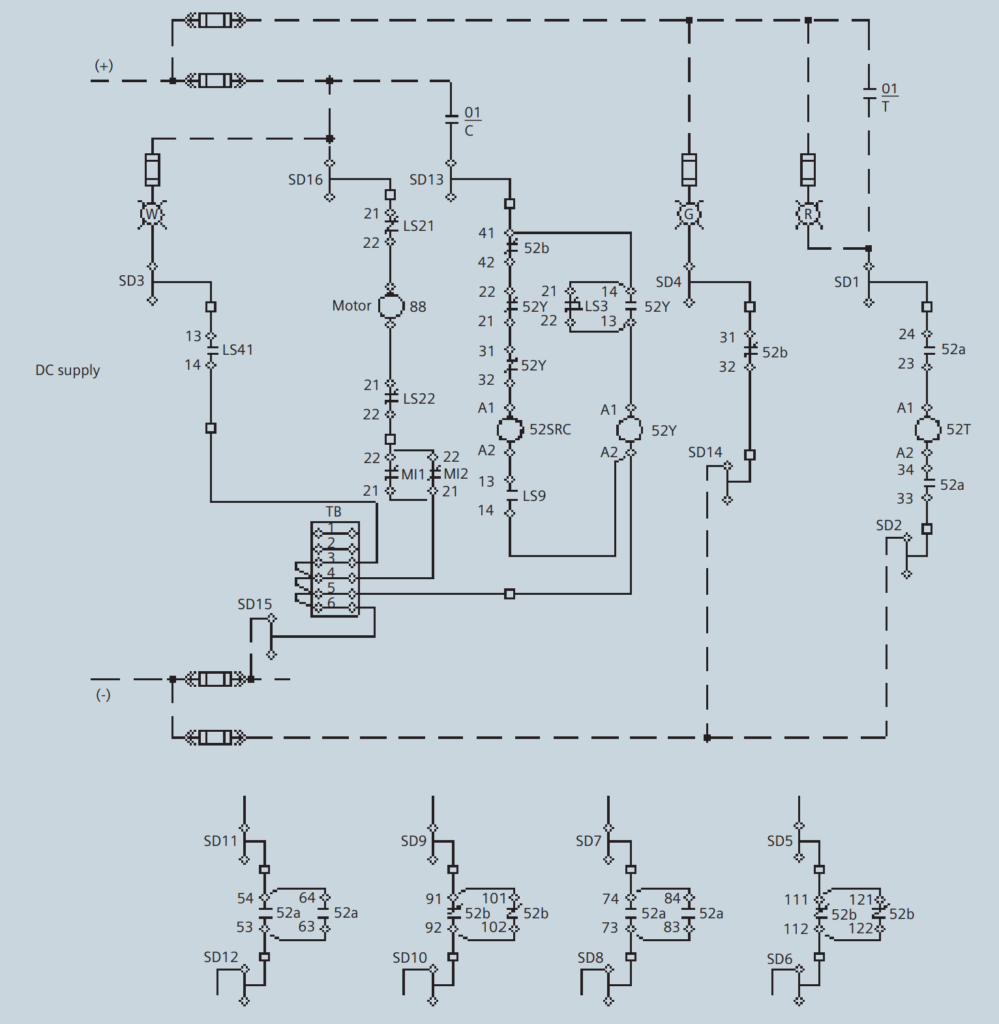
Lubrication for Vacuum Circuit Breaker
Lubrication is an essential aspect of maintaining a vacuum circuit breaker (VCB) to ensure its proper functioning and longevity. The VCB contains moving parts and mechanisms that require lubrication to reduce friction, prevent wear and tear, and enhance overall performance. Proper lubrication can help prevent malfunctions, ensure smooth operation, and extend the service life of the circuit breaker. Here are some key points related to lubrication for vacuum circuit breakers:
- Lubricant Selection: The choice of lubricant is crucial for VCBs. High-quality, non-reactive, and long-lasting lubricants are preferred to withstand the challenging operating conditions, such as high voltages and vacuum environments. Silicone-based or fluorinated greases are commonly used due to their excellent dielectric properties and resistance to oxidation.
- Contact Mechanisms: VCBs contain moving contact mechanisms that open and close during operations. These contact surfaces need to be properly lubricated to ensure smooth contact movement and minimal arcing. Lubrication helps reduce friction and wear between the contacts, preventing damage and ensuring reliable switching.
- Drive Mechanisms: VCBs may have various drive mechanisms, such as springs or magnetic actuators, which require lubrication to facilitate smooth operation and precise control. Proper lubrication of drive mechanisms prevents mechanical failures and guarantees accurate circuit breaking.
- Maintenance Schedule: Regular maintenance is essential for VCBs, including lubrication checks and re-application. A well-defined maintenance schedule should be followed to inspect lubrication levels, cleanliness, and overall condition of the lubricated parts.
- Contamination Control: Special attention should be given to preventing contamination of the lubricant, as dirt or foreign particles can compromise the performance of the VCB. Proper sealing and protection of lubricated components help maintain a clean and functional circuit breaker.
- Manufacturer Recommendations: VCB manufacturers provide specific guidelines and recommendations for lubrication based on the design and operational requirements of their equipment. Following the manufacturer’s instructions is crucial to ensure optimal performance and avoid voiding warranty conditions.

In conclusion, proper lubrication is a vital aspect of VCB maintenance to ensure reliable and efficient operation. By using suitable lubricants and following manufacturer guidelines, operators can enhance the performance and longevity of vacuum circuit breakers, making them a reliable component in electrical power distribution and protection systems.
Conclusion
The Vacuum Circuit Breaker has emerged as a reliable and eco-friendly solution for interrupting fault currents and controlling high-current loads. With its excellent dielectric properties and low maintenance requirements, VCBs have become a key component in modern electrical networks. As technology continues to evolve, Vacuum Circuit Breakers are expected to play an increasingly significant role in the future of power distribution and transmission.
Vacuum Circuit Breaker Technical Problems and Its Solution
Vacuum circuit breakers (VCBs) are generally reliable and widely used in various electrical applications due to their superior arc-quenching properties and low maintenance requirements. However, like any electrical equipment, VCBs can experience problems in the field that may affect their performance. Here are some common VCB problems and possible solutions:
- Contact Welding:
Problem: Contact welding occurs when the vacuum interrupter’s contacts become stuck together due to a high fault current or an overcurrent situation, preventing the circuit breaker from opening.
Solution: To resolve contact welding, the VCB must be replaced or the vacuum interrupter replaced or refurbished by a qualified technician. - Contact Erosion:
Problem: Over time, the VCB’s contacts may experience erosion, leading to increased contact resistance and reduced current-carrying capacity.
Solution: Regular maintenance and inspection can help identify contact erosion early. If significant erosion is detected, the contacts should be replaced with new ones to maintain proper performance. - Vacuum Integrity Failure:
Problem: VCBs rely on vacuum as an arc quenching medium. If the vacuum integrity is compromised due to leaks or other factors, the breaker may fail to quench the arc properly.
Solution: Proper maintenance, regular vacuum integrity tests, and timely replacement of damaged vacuum interrupters can help prevent vacuum integrity failure. - Mechanical Failure:
Problem: VCBs contain various mechanical components such as springs, operating mechanisms, and linkage systems that may experience wear and tear, leading to mechanical failures.
Solution: Routine inspection, lubrication, and replacement of worn-out mechanical parts can help prevent mechanical failures and ensure smooth operation. - Capacitive Current Switching:
Problem: When switching capacitive loads, VCBs may encounter inrush currents that could cause voltage fluctuations and potential damage to the circuit breaker.
Solution: Capacitor banks or other capacitive loads should be pre-charged to reduce the inrush current, or VCBs with special capacitive switching features should be used. - Failure to Close/Open:
Problem: VCBs may sometimes fail to close or open due to control circuit issues or malfunctioning closing/opening coils.
Solution: Inspect the control circuits, ensure proper voltage supply to the closing/opening coils, and replace any faulty components as needed. - External Contamination:
Problem: External contamination, such as dust, moisture, or conductive particles, can accumulate on the vacuum interrupter’s surface, affecting its insulation properties.
Solution: Regular cleaning and protection of the vacuum interrupter from environmental factors can prevent external contamination and maintain the VCB’s insulation performance.
It is important to remember that troubleshooting and repairing VCBs should only be performed by qualified and trained personnel to ensure safe and effective solutions to the problems encountered in the field. Regular maintenance and adherence to manufacturer guidelines can help minimize VCB problems and extend their service life.
